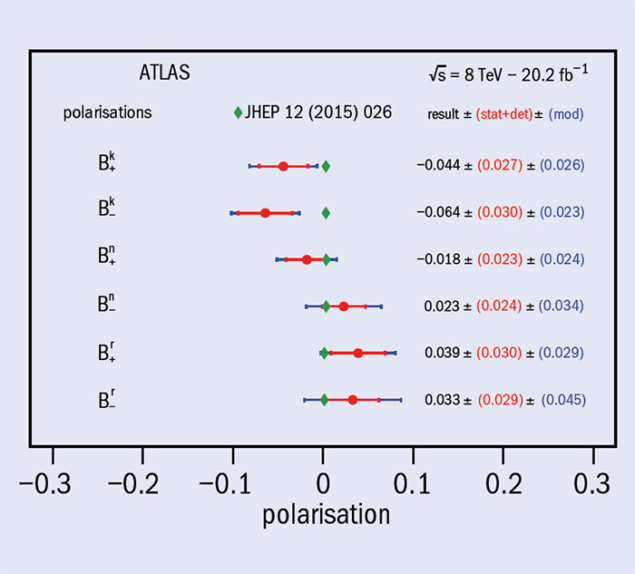
The large mass of the top quark means that the top-quark sector has great potential for gaining a deeper understanding of the Standard Model (SM) and for revealing new physics beyond it. With the large statistics available at the LHC, very precise measurements of the top-quark properties are possible. Two recent analyses performed by ATLAS based on proton–proton collisions recorded at an energy of 8 TeV have allowed the collaboration to probe the angular distributions of the top quark and its decay products in unprecedented detail.
The first analysis concerns the polarisation of W bosons produced in the decays of top-quark–antiquark pairs, which is determined by measuring the angle between the decay products of the W and the b-quark from the top decay. Both leptonic and hadronic W decays were identified, and the fractions of longitudinal, left- and right-handed polarisation states fitted from the angular distributions. The results from ATLAS are the most precise to date and are in good agreement with the SM predictions. This measurement is also used to probe the structure of the Wtb vertex, which could be modified by contributions from new-physics processes and thus allows new constraints to be placed on anomalous tensor and vector couplings.

The goal of the second analysis was to completely characterise the spin-density matrix of the top-quark–antiquark pair production. This required the measurement of 15 independent variables, 10 of which were never previously measured. Specifically, ATLAS measured the polarisation of the top quark and the spin correlation between the top and anti-top along three different spin-quantisation axes: the helicity axis, the axis orthogonal to the production plane created by the directions of the top quark and the beam axis, and a third axis orthogonal to the former two. Using this scheme, the collaboration was able to measure new “cross-correlation” observables for the first time, based on the angular distributions of the leptons from the top-quark decays. The distributions were corrected back to generator-level to allow the results to be interpreted in terms of new physics models, and so far all results are in agreement with the SM expectations.
These studies of the angular distributions of top-quark decays will benefit from the larger data sample collected at 13 TeV, allowing stronger constraints to be placed on potential new-physics contributions or opening new opportunities to observe deviations from the SM.





